A Journey of Reverence: Shooting a Holland & Holland Royal
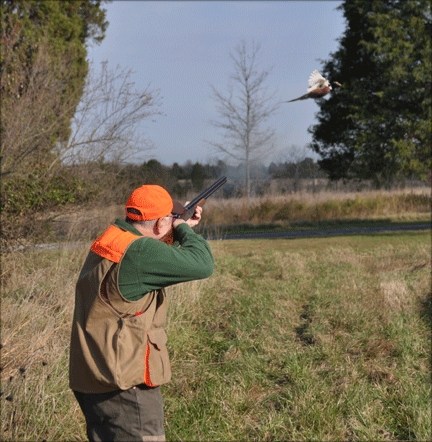
Down the hill, behind the old Jefferson County manor house, a six-point buck stood alert under the autumn sky. The dense trees put forward garden colors of carrots, raspberries, pumpkins and sweet peas. I rested against the stone wall. Traces of summer lingered with the few insects flitting around in the warm dusk. As the moon grew brighter I knew Prospect Hall would justly serve the Holland & Holland Royal in the trunk of my car.
The shotgun had been loaned to me by David Cruz, the operations manager with Holland & Holland on East 40th Street in Manhattan. The Royal 20 bore over/under carried serial number 5100P6. Completed in 1991, it was the prototype of the Royal over/under line unveiled in 1992. Although in the ownership of Holland & Holland all these years, it has been shot countless times by enthusiasts deliberating whether or not to acquire such a fine four-pin sidelock priced at $104,000 if purchased new today.
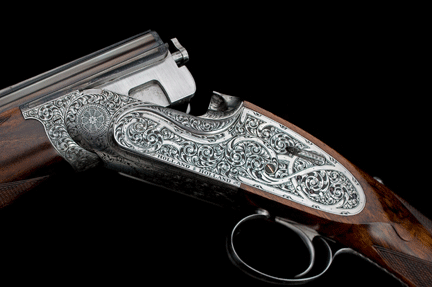
David generously let me borrow the Royal for a week – not a particularly long time to find a place worthy of this upland legend. Short of flying to England or Scotland, few destinations came to mind within driving distance of my home in Maryland that would let me pay homage to this well-worn beauty.
The handling marks on the smoky Turkish walnut of the straight English stock, the bluing rubbed thin on the trigger guard and graceful tang with the serial number in gold, the splendid Royal floral engraving burnished to an everlasting patina – the Royal spoke of an autumn reckoning as winter slowly but surely gathered.
Being a son of the industrial age, I felt a resonance with this Royal in particular. Despite the price tag, the Royal was a blue-collar tour de force, somewhat tired but sturdy and dependable. Yes, Holland & Holland had long ago transitioned to sophisticated computer-driven machines for the larger components; but on the upper floors of the Victorian-era London shop there remains a minion of dedicated craftsmen in oil-stained aprons, who preferred to work in natural light, hand-shaping the stocks, hand-striking the barrels and filing to perfection the tiniest component for each individual shotgun and rifle.
How many hours of dedication had gone into making the Royal on loan to me? In an overhaul of the pre-World War II Royal, this over/under Royal took seven years to go from drawing board to gun number 5100P6. The amount of man-hours in this particular shotgun could have amounted to more than it takes to build a modern-day subdivision. I needed to locate a fitting venue to shoot the Royal.
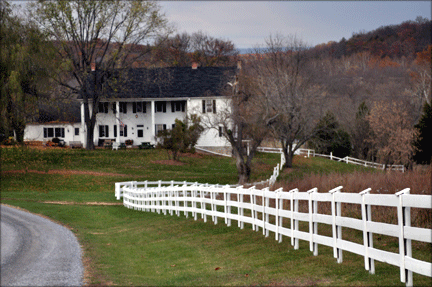
Prospect Hall.
I called my friend, Phil Dietrich, the Hunt and Field Director, at the Prospect Hall Shooting Club in Kearneysville, West Virginia. About a 90-minutte drive from where I live, Prospect Hall was located in the bread basket of the Confederacy. It was hallowed ground where blood had been spilled by both armies. Under Phil’s devoted stewardship, over the past five years Prospect Hall had established a well-earned, walk-up shooting tradition. (Read our earlier story of shooting clays at Prospect Hall.)
Phil told me over the phone there were plenty of chukars and a few pheasants in the fields. I was welcome to come the night before the hunt. The house would be unoccupied, meaning that I would have the entire place to myself.
When I arrived at around 4:00 pm, Phil was still out on the sporting clays course wrapping up the lesson that he had mentioned could possibly delay him. With time to kill, I sat in one of the Adirondack chairs on the stretch of front porch then lit a cigar with a sturdy wood match. In my circle, we call that aroma therapy.
There’s an old Land Rover that has never left Prospect Hall and when it came down the road beside the faded red barn I walked over to meet Phil. I took the Royal into his combined gun room and office, which offered a spectacular view of the woods and pond below.
Phil started cleaning the Purdey that belonged to his client – a trim, elderly man who removed his field jacket. We started talking, when Phil politely interjected that the gentlemen had actually won a Pulitzer Prize for his book on the Vietnam War. The man seemed embarrassed by this new revelation, but Prospect Hall can be deceptive. Its humble interior and rural façade draw the most powerful insiders from the Metro DC region to this “gentleman’s farm.”
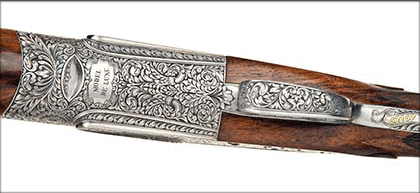
The man and I continued talking about Holland & Hollands, Purdeys and other fine British shotguns when he placed a wrinkled brown bag on his lap and took out a sandwich wrapped in aluminum foil, which he slowly unfolded to reveal a peanut butter and jelly sandwich on soft brown bread cut into quarters.
With nightfall nearly upon us, the man prepared to leave Prospect Hall. We exchanged business cards and after he left I noticed his card of beige stock and pine-green lettering showed a Washington, DC address without an email and cell phone.
Phil locked up the Royal and we crossed into the manor house. He started a fire in the well-stoked hearth of the sitting room. We carried my bags to the main bedroom on the second floor with wide, creaking floor boards that showed daylight between them.
In his grand hospitality, he had offered to cook dinner in the modest commercial kitchen, but since I was the only guest I declined so that he could be at home with his beautiful family. He prepared a pot of coffee for the next morning and assured me that if any problems arose I could reach him anytime on his cell phone and he would be here within minutes.
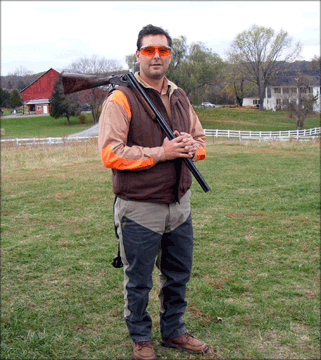
As it turns out, I had brought my own provisions: smoked salmon, salami, a hunk of smoked gouda and crackers – along with a flask of Laphroaig single malt scotch and a leather cigar holder filled with torpedoes.
I laid out the spread on the large mahogany table in the dining room, the chandelier casting ample light for me to accompany my repast with the book “Plain Directions for Acquiring The Art of Shooting on the Wing: With Useful Hints Concerning All That Relates To Guns and Shooting” written in 1873 by someone called “An Old Gamekeeper.”
Moving into the sitting room, I occupied a weathered leather sofa, its companions on the other side of the coffee table. The hearth had the same appetite for wood as Diamond Jim Brady for sirloin. The magnificent heat, the scotch, the cigars and the deep history of the house mingled with the Old Gamekeeper’s voice.
I awoke the next morning to an Indian Summer. Phil stood at the stove scrambling eggs, frying sausage and toasting bagels under the broiler. We enjoyed breakfast and fine conversation in the dining room.
We returned to the gun room, waiting for our guide. I shouldered the Royal. At 6 pounds, 3 ounces and with a 14 ¾-inch length of pull it came up quick and authoritative thanks to the extraordinary balance centered on the trunnions and a frame rounded to the contour of my left hand.
Given its 20 bore frame, the composed ergonomics extended to the scaled splinter forend that had an easy-to-point feel.
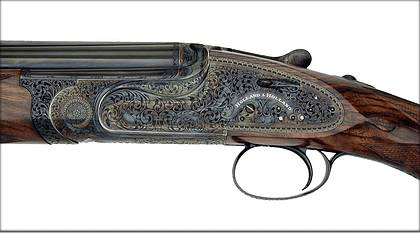
The Royal cracked open with surprising ease. Push the top lever and the barrels gently tipped forward, while the ejectors produced a brusque click. The same cams on the bottom of the demiblock that assisted the ejectors returned the favor when you closed the gun. The cams moved in channels that were machined into the bottom of the receiver and coupled with the center lock resulted in a square, wobble-free fit.
The shotgun’s non-ventilated barrels were Superior Proofed for 2 ¾ inch or 3 inch shells. The boring of ¼ and ½ were the rough equivalents of improved cylinder and modified. At 28 inches, they were the perfect length for snap-shooting flushed birds.
Our guide arrived and he was a hearty young guy named J.R. Rudy who operated Rudy’s Kennnels also in Kearneysville.
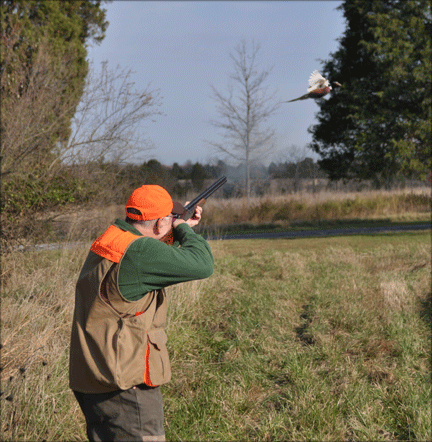
The Holland & Holland 20-bore Royal about to bag its quarry.
Phil, Rudy and I started for the fields of tall grass with Rudy’s two dogs, a pointer and a retriever. We were talking and laughing all the way and I barely noticed I was carrying a shotgun. The Royal balanced so well it naturally integrated into my stride.
We hunted for nearly three hours. I wasted a few early shots getting acquainted with the Royal – basically overpowering the gun’s natural pointing ability. Once I began to trust the Royal, it performed flawlessly. I’d used Holland & Holland Royal Game shells packed with #7½ shot and 7/8 ounce load. The ammo seemed perfectly matched to the gun and the immediacy of the Royal’s handling – its intuitive hunting characteristics as so wonderfully executed in the 3.2-pound inertia trigger – satisfied the commitment of those craftsmen in London.
The Royal was a shotgun that empowered you – lifting your spirit with each amazing swing that ultimately brought down seven chukars and one plump pheasant. And the pheasant dropped from a magnificent shot – the bird startled from behind a tree and flew into my blind spot when I whirled around and the Royal took over for a clean shot to the breast that sent it tumbling in an eruption of feathers.
In the end, Prospect Hall and the Holland & Holland Royal were meant to be together on that charmed Indian Summer afternoon, and I was delighted to be part of it.
Irwin Greenstein is Publisher of Shotgun Life. You can reach him at letters@shotgunlife.com.
Resources:
Holland & Holland
http://www.hollandandholland.com
Prospect Hall

Irwin Greenstein is Publisher of Shotgun Life. Please send your comments to letters@shotgunlife.com.


Comments